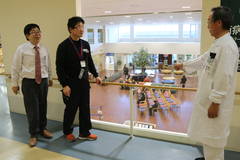Four years on from the Great East Japan Earthquake and Tsunami – Ishinomaki hospital, a model of urban disaster preparedness
2015/03/02
By Hler Gudjonsson, IFRC

Director of the Ishinomaki Red Cross Hospital, Dr. Iwao Kaneda shows visitors the main waiting hall that can be transformed into a large scale emergency within a few hours.
The Red Cross hospital in Ishinomaki was the only hospital to withstand the force of the Great East Japan earthquake and Tsunami on 11 March, 2011. In 2006, the hospital had been relocated to a new site 4.5 km from the coast. The new building was designed to withstand the most violent of earthquakes, and still be able to continue providing lifesaving medical services to the population. Despite the fact that the tsunami had swept through the city, destroying everything in its path, the hospital escaped unscathed.
“When the earthquake struck the city, for about a minute the tremors were so violent that we could not move,” recalls Dr. Iwao Kaneda, Director of the hospital, “but we were well prepared, an hour later we had launched an emergency operation.”
Detailed and meticulous disaster preparedness plans ensured that the hospital had a secure supply of clean water, as well as fuel for its emergency generators. However, all of the 11 elevators in the hospitals had stopped working and for several days the staff needed to carry supplies and patients up and down the narrow stairs. Despite this, the hospital was able to continue providing advanced medical services uninterrupted. Oxygen valves and other devices that had been pre-installed in the walls of hallways and waiting rooms allowed every available space to be transformed into mass casualty facilities without delay.
One of the remarkable designs of the hospital is that from the outside it appears to be an ordinary building, while in fact the whole structure is built on top of an enormous steel frame which rests on rubber cushions that can absorb the shocks of even a 9.0 magnitude earthquake. This ingenuous feature prevented any serious damage to the building and kept it operational.
After the disaster, the hospital had to serve an area five times bigger than its regular catchment area. “The extreme workload was very demanding, and we realized that taking good care of our staff was one of our most important tasks,” said Dr. Kaneda. “Many of them had lost their homes, and we got a hotel room for them so they would get proper rest. At the evacuation centers they would probably have been asked to help people who needed medical attention, and would have been unable to sleep.”
Today, four years on, morale among the staff is better than ever. They have accumulated rich experience and knowledge about how to cope in emergencies and the recognition that the hospital has gained for its services has attracted talented physicians from all over Japan. Better access to financial resources has made it possible to add extensions to the building. A nursing school has even been built on its premises and will open this March.
Dr. Kaneda still vividly remembers the difficult days that followed after the disaster. “I have three sons but I was unable to contact my family for some time after the disaster. For a couple of days I had no idea that I had become a grandfather,” said Dr. Kaneda. “In fact, after the earthquake I was unable to think about anything except my work and that I must try to save as many lives as possible. When I got the phone call with the news of my grandchild it was really a wonderful surprise.”
Although other hospitals have been restored, the Red Cross hospital in Ishinomaki remains one of the most indispensable medical facilities in the city, and continues to offer a complete range of specialized services such as cancer treatment.
さんIMG_0396-cropped-proto-custom_318.jpg)
“I cannot live without the Ishinomaki Red Cross Hospital,” says Mr. Kiyoto Sakamoto, a patient coming to the hospital for treatment. “In the past year I felt that my life had returned to normal. I was lucky enough that my house was not destroyed during the disaster. However, this year I was diagnosed with lung cancer and had to start coming to the hospital. I had my first session of radiotherapy today, and I will also need chemotherapy,” says the 76 years old retiree.
Mr. Sakamoto is not the only inhabitant in Ishinomaki who relies on the advanced treatment still provided by the hospital. 64 years old Mr. Shigeru Konno is confined to a wheelchair, and was brought there by his family. “Suddenly one day in June I was unable to move either my arms or legs,’ says the former member of the Japanese Self Defence Forces. “The doctors found a tumor in my brain and I had surgery to have it removed. I have been coming here regularly for many months, and the doctors treat me quickly when I need it. “















